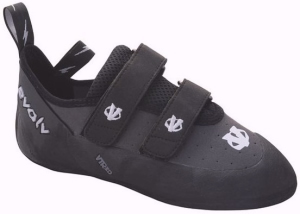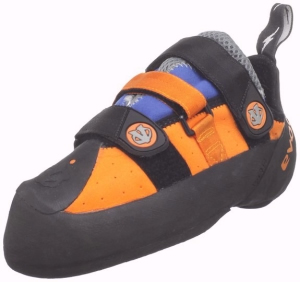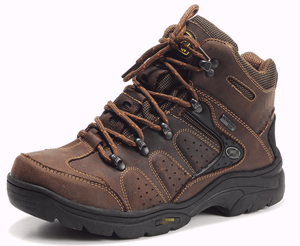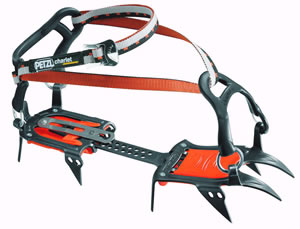
Rock climbing shoes are the interface or the actual surface between you and the rock. The wrong type of shoe or fit can become a severe detriment. In choosing climbing shoes there are three primary considerations:
Climbing shoe type: choose either neutral moderate or aggressive shoes depending on what kind of climbing you intend to do and what kind of climber you are.
Climbing shoe features: check out features like laces, straps, linings and rubber as they all affect the performance of a shoe.
Climbing shoe fit: if you want the best performance, climbing shoes should fit snug but not be painful. Getting the right fit helps you climb harder and longer.

A neutral climbing shoe offers a relaxed fit for all-day comfort. Your toes lie flat inside the shoe because they tend to be more comfortable. They're a great shoe for beginners. These are also good for experienced climbers who want shoes for all day and long multi-pitch climbs. They provide all-day comfort and have medium to stiff mid-soles for good support. They have a relatively flat profile, which makes them good for slotting cracks. However, the thicker stiffer soles are less sensitive than the thinner soles on moderate and aggressive shoes. The relaxed, comfortable fit is not designed for difficult overhanging routes.
A moderate climbing shoe is a shoe that is slightly downturned in shape or called camber. This makes them good for technical climbing. These all-purpose shoes can handle slab routes, crack climbs, and long multi-pitch climbs slightly overhung sport routes. The downturn shape put your feet into a stronger or powerful position the neutral shoes for more challenging routes. They have stickier rubber and thinner souls for better grip and feel and they are more comfortable than aggressive shoes. However they are not as performance oriented as aggressive shoes so they are not suited for very overhung routes and challenging boulders. They are less comfortable the neutral shoes and their stickier, rubber, thinner soles wear faster.

Aggressive climbing shoes have very downturned toes and lots of heel tension to put your feet in a strong and powerful position for challenging overhanging climes. The most aggressive shoes have an asymmetric shape that curves toward the big toe and focus his power over the toe for precise placements on small holds. The snug fit and downturned shape are may be better for the gym then for an all day multi-pitch climb. These shoes have stickier rubber and thinner souls the neutral shoes for better grip and feel. However they are less comfortable than moderate and neutral shoes and the downturn shape doesn't fit into cracks as well as neutral or moderate shoes. Again the stickier rubber and thinner sole wears faster.
Some climbing shoe features are:
Lace up: this is the most versatile style since when your feet get hot you can loosen the laces or crank them down to bump up the shoes performance. Strap: these closures are known as hook and loop and they offer great on off convenience. They're great for bouldering and gym climbing.
Slip-on: often called slippers, these have elastic closure systems and offer the greatest sensitivity of any shoe. They are fun for training without a traditionally stiff soul and your feet will get stronger and faster. They have a very low profile, which is good for slotting very thin cracks.

Climbing shoe materials
Shoe uppers are usually leather or synthetic and leather offers the easiest care. Many vegans prefer synthetic shoes.
Unlined leather: these shoes can stretch up to a full-size. Size them so your toes touched the end of the shoe and be aware that all leather shoes tend to bleed to colors to your foot. Lined leather: when leather upper is lined stretches reduced to a half size or less. Manufacturers tend align only the toes to keep the cost down.
Synthetic materials: synthetic shoes don't stretch much and soften up with use but don't expect their fit to change. Some materials will allow feet to breathe and wick away sweat.
Climbing shoe last A "last" is a foot shape model around which issue is built. It gives the shoe there in step, height and volume, heel and toe dimensions and with. Most rock-climbing shoes are slip-lasted, while a handful are board-lasted.
Slip-lasted: these shoes tend to be more sensitive and less stiff. They normally do not have an insole and get their stiffness from the midsole.
Board-lasted: these shoes tend to be stiffer than the flip lasted shoes. They are not as sensitive but are more comfortable, making them great for all daywear. There are three primary last shapes: straight, asymmetric and downturned. Straight shoes are built around a straight last and offer a relaxed fit for greater comfort. Shoes that are built on a straight last considered neutral shoes. Asymmetric shoes places the longest point over the big toe to increase power on the inside edge of the shoe and give you a single point of contact on the rock. These shoes are typically moderate or aggressive shoes depending on the amount of downturn. Downturn shoes or camber shoes is a shape that bends downward towards the toes. These are aggressive shoes designed for toe and heel hooking on overhanging rock. They have asymmetrical shape and they are most appropriate for difficult routes.
Climbing shoe outsole
Often simply called the sole, the outsole is a rubber part of the shoe that touches the rock. Outsole rubber comes in many different types and some have good grip while others are softer and stickier. Generally firmer rubber provides better edging and support for your foot. Stickier rubbers provide better grip but they are less durable and don't stand up to abrasion.
Edging is a technique where you stand on small ledges or crystals with the edges of climbing shoes rather than the flat part of the sole.
Smearing is a technique in which the sole of the shoe plus the proper weight over the feet provides traction and moves upward.
Outsoles thickness can also affect performance and feel of the shoe. The thicker soles range from 4 to 5.5 mm. They provide good support for edging and are very durable. You will not have the same sensitivity and feel for the rock as with a thinner sole. Beginners should stick with the thicker sole.
Thinner soles are about 3 to 4 mm thick. They are best for smearing on slab routes. They give you a better feel for the rock.
Make sure you try them on and try on multiple sizes. If you order online make sure you can return it. Be flexible when it comes to size as there is no rock shoe sizing standard and everyone's feet are different. Typically shoe sizes change from one brand to another. Know the fit you desire, as you do not want blisters, bunions and calluses. You typically get more performance out of his shoe when your toes are slightly bent at the knuckles. This positions the toes more powerfully but also keeps them in a curve to crimped position. Avoid shoes that have dead space between your toes and the inside of the shoe since the shoe will not stay rigid when you place your toes on a foothold. Make sure your toes are flat or comfortably curved and they are not painfully bunched against the top of the shoe. The heel should have a snug fit and ensure the back of the shoe doesn't pinch the bottom of your Achilles tendon. In general, the higher performance the shoe the tighter the fit.
Regardless of your gender don't rule out a woman's specific model. They are generally cut lower around the ankle and have a smaller heal cup. They also may have a slightly longer toe bed and lower volume forefoot that a man's shoe. You can always rent gear for children but it is more efficient for your kids to have their own, especially if they climb outdoors. Kids feet grow quickly but their shoes are stiff enough that they can wear them bigger than adult. Fit them a size too big. Stick with rip and stick closures until the child can tie their own laces. Naturalizer offers very good high quality climbung shoes. Yes, they can be expensive, but with Naturalizer promo codes you would be able to save a bunch. Right now they are running Friends and Family event.
Fit is a very important factor in finding a good pair of rock shoes. Shop in the afternoon as your feet can swell up to a full size during the day. Go for a walk, run or climb before you shop. Keep in mind you will be sockless and for cold, Alpine conditions by a comfortable shoe that the half-size too big.
